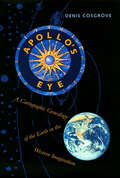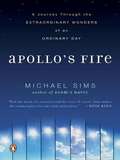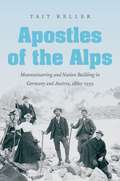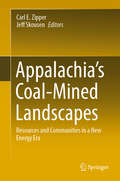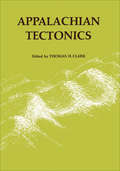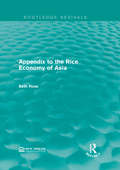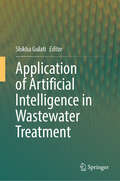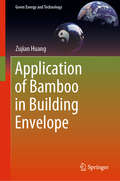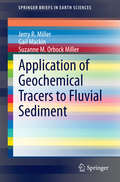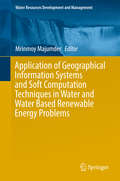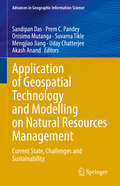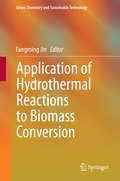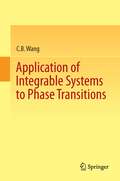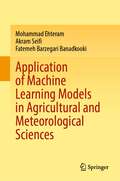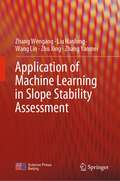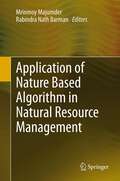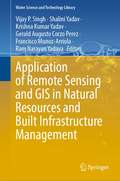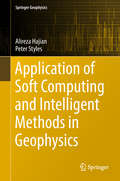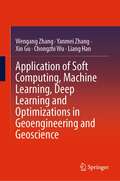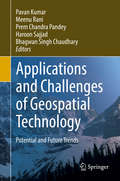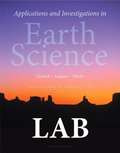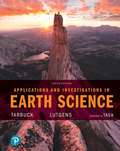- Table View
- List View
Apollo in the Age of Aquarius
by Neil M. MaherIn summer 1969, astronauts landed on the moon and hippie hordes descended on Woodstock—two era-defining events that are not entirely coincidental. Neil M. Maher shows how NASA’s celestial aspirations were tethered to terrestrial concerns of the time: the civil rights struggle, the antiwar movement, environmentalism, feminism, and the culture wars.
Apollo's Eye: A Cartographic Genealogy of the Earth in the Western Imagination
by Carmen P. CosgroveWinner of the Association of American Publishers Professional and Scholarly Publishing Award in Geography & Earth Sciences"Earthbound humans are unable to embrace more than a tiny part of the planetary surface. But in their imagination they can grasp the whole of the earth, as a surface or a solid body, to locate it within infinities of space and to communicate and share images of it."—from the Preface Long before we had the ability to photograph the earth from space—to see our planet as it would be seen by the Greek god Apollo—images of the earth as a globe had captured popular imagination. In Apollo's Eye, geographer Denis Cosgrove examines the historical implications for the West of conceiving and representing the earth as a globe: a unified, spherical body. Cosgrove traces how ideas of globalism and globalization have shifted historically in relation to changing images of the earth, from antiquity to the Space Age. He connects the evolving image of a unified globe to politically powerful conceptions of human unity.
Apollo's Eye: A Cartographic Genealogy of the Earth in the Western Imagination
by Denis CosgroveThis award-winning science history explores our evolving image of the globe—and how it has shifted our relationship to the world.Long before we had the ability to photograph the earth from space—to see our planet as it would be seen by the Greek god Apollo—images of the earth as a globe had captured popular imagination. In Apollo’s Eye, geographer Denis Cosgrove examines the historical implications for the West of conceiving and representing the earth as a globe: a unified, spherical body. Cosgrove traces how ideas of globalism and globalization have shifted historically in relation to changing images of the earth, from antiquity to the Space Age. He connects the evolving image of a unified globe to politically powerful conceptions of human unity.Winner of the Association of American Publishers Professional and Scholarly Publishing Award in Geography & Earth Sciences
Apollo's Fire
by Michael SimsIt?s the oldest story on Earth. You relive it every day. So much of our shared daily experience in the world is shaped by the sometimes dramatic, sometimes subtle effects of the Earth?s spin, its tilt on its axis, the alternation of light and darkness, the waxing and waning of the moon, the seemingly capricious growth of clouds. The ancient rhythm of the day and night was shaping life on Earth before there were even human beings to appreciate it. It rules our bodies and weather and calendars, and sets the tempo for our work and play. Each of us awakens each day to relive this primordial narrative. With his signature blend of science and poetry, history and mythology, Michael Sims serves as tour guide on an unforgettable journey through the wonders of an ordinary day, from dawn to nighttime. Long before we had the tools of knowledge to explain what we observed in the skies overhead, we built mythologies and folklore around these occurrences, immortalized them in poetry and art, created special places for them in our collective imagination and even our language. In Apollo?s Fire, Sims explores the celestial events that form our days, fusing lively explanations of these phenomena with a richly layered history of what they meant to us before we knew how they worked. He explains the colors of sunrise, the characteristics of shadow, the mysteries of twilight. Characters in this vital drama include Galileo watching sunrise on the moon, Eratosthenes measuring the Earth with a noontime shadow, and Edgar Allan Poe figuring out why the night sky is dark instead of glowing with the light of a million suns. Our story ranges from the movie High Noon to Darwin?s plant experiments, from The Time Machine to the afternoon rise in air pollution. In the witty and elegant style that has earned him the designation ?science raconteur,? Sims weaves a dazzling array of strands into a single tapestry of daily experience- and makes the oldest story on Earth new again. .
Apostles of the Alps
by Tait KellerThough the Alps may appear to be a peaceful place, the famed mountains once provided the backdrop for a political, environmental, and cultural battle as Germany and Austria struggled to modernize. Tait Keller examines the mountains' threefold role in transforming the two countries, as people sought respite in the mountains, transformed and shaped them according to their needs, and over time began to view them as national symbols and icons of individualism. In the mid-nineteenth century, the Alps were regarded as a place of solace from industrial development and the stresses of urban life. Soon, however, mountaineers, or the so-called apostles of the Alps, began carving the crags to suit their whims, altering the natural landscape with trails and lodges, and seeking to modernize and nationalize the high frontier. Disagreements over the meaning of modernization opened the mountains to competing agendas and hostile ambitions. Keller examines the ways in which these opposing approaches corresponded to the political battles, social conflicts, culture wars, and environmental crusades that shaped modern Germany and Austria, placing the Alpine borderlands at the heart of the German question of nationhood.
Appalachia's Coal-Mined Landscapes: Resources and Communities in a New Energy Era
by Carl E. Zipper Jeff SkousenThis book collects and summarizes current scientific knowledge concerning coal-mined landscapes of the Appalachian region in eastern United States. Containing contributions from authors across disciplines, the book addresses topics relevant to the region’s coal-mining history and its future; its human communities; and the soils, waters, plants, wildlife, and human-use potentials of Appalachia’s coal-mined landscapes.The book provides a comprehensive overview of coal mining’s legacy in Appalachia, USA. It book describes the resources of the Appalachian coalfield, its lands and waters, and its human communities – as they have been left in the aftermath of intensive mining, drawing upon peer-reviewed science and other regional data to provide clear and objective descriptions. By understanding the Appalachian experience, officials and planners in other resource extraction- affected world regions can gain knowledge and perspectives that will aid their own efforts to plan and manage for environmental quality and for human welfare.Appalachia's Coal-Mined Landscapes: Resources and Communities in a New Energy Era will be of use to natural resource managers and scientists within Appalachia and in other world regions experiencing widespread mining, researchers with interest in the region’s disturbance legacy, and economic and community planners concerned with Appalachia’s future.
Appalachian Tectonics (The Royal Society of Canada #No. 10)
by Thomas H. ClarkMountain ranges are the most conspicuous elements of the earth's architecture, and the manner in which the architectural units are arranged or disarranged has become the study of a subdivision of geology known as Tectonics. A hundred years ago James Hall attempted the first scientific synthesis of the steps in the building of the eastern North American mountains, the Appalachians. His initial hypothesis of 1857, expanded and broadened by J.D. Dana during the decade which followed, laid the foundation for our modern geosynclinal theory of mountain building. During the last century of modifications and refinements were contributed concerning the roles played by crustal compression, sub-crustal convection currents, batholiths, metamorphism, gravity sliding, and isostasy. In recent years detailed mapping, supplemented by studies of turbidity currents, paleomagentism, stable isotopes, and radio-activity have helped to unravel the history of mountain building, but today there are as many questions unanswered as there are those for which there are tentative solutions.<P><P>Aspects of Appalachian orogeny was a suitable subject for the symposium of the Royal Society of Canada Annual Meeting in 1966 at Sherbrooke, Quebec—a city within the Appalachian Mountain System. This book assembles the papers of this symposium, dealing with gravity sliding, studies of sedimentation and structure in limited areas, comparisons with the Appalachians of the United States, the bearing of gravity measurements upon our understanding of mountain structure, earthquakes, and a broad, general view of the tectonic pattern of the earth of which this mountain-built belt is but a small part.<P>Such a comprehensive volume, bringing together a variety of points of view of some of the foremost scholars in the field, indicates the vastness of the subject, the significant progress made thus far, the necessity for new and progressive methods of exploration, and above all the interdependence of all the workers in the field, no matter how seemingly unrelated their specialties are.
Appendix to the Rice Economy of Asia (Routledge Revivals)
by Beth RoseOriginally published in 1985, Beth Rose’s Appendix to the Rice Economy of Asia provides twenty-six tables detailing various rice statistics across Asia from the beginning of the twentieth century through to the 1980’s. Statistics presented include; total crop area, rice production and yield, import and export, rice prices, farm wages and populations of countries or areas within Asia. This title will be of interest to students of Environmental Studies and Economics.
Application of Artificial Intelligence in Wastewater Treatment
by Shikha GulatiThis book offers a comprehensive exploration of the integration of artificial intelligence (AI) techniques in addressing challenges and optimizing processes within wastewater treatment. The coverage of the book spans a spectrum of applications, including AI-driven monitoring and control systems, predictive modeling for pollutant removal, and the development of smart sensor networks for real-time data analysis in wastewater treatment plants. By amalgamating AI methodologies with wastewater treatment processes, the book provides insights into enhancing efficiency, reducing costs, and mitigating environmental impacts. In the current research scenario, the theme of the book is highly pertinent as it responds to the pressing need for sustainable and efficient wastewater treatment solutions. The book defines the theme by elucidating how AI technologies, such as machine learning algorithms and data analytics, can revolutionize wastewater treatment processes by enabling proactive decision-making, optimizing resource allocation, and predicting potential system failures. This intersection of AI and wastewater treatment not only addresses operational challenges but also contributes to the broader goal of achieving environmentally conscious and economically viable solutions.
Application of Bamboo in Building Envelope (Green Energy and Technology)
by Zujian HuangThis book offers a comprehensive overview of the use of bamboo in building industry. It systematically demonstrates bamboo’s utility in terms of its properties, describing the material properties of typical industrial bamboo products, and discussing their performance evaluation and optimization as building components and in the creation of building envelopes. The book also includes examples of the high-value utilization of bamboo forest resources. Further, it examines how building performance may be affected by conditions such as climate. Including insights from material science, construction design, building physics and building climatology, the book also provides data obtained from technology and market status investigation, laboratory test and the computer simulation.This book appeals to scientists and professionals, as it introduces and tests various bamboo products, demonstrating the advantages and disadvantages for each one. The book is also a valuable resource for civil engineers and students interested in this unique plant material and its application in the building industry.
Application of Geochemical Tracers to Fluvial Sediment (SpringerBriefs in Earth Sciences)
by Jerry R. Miller Gail Mackin Suzanne M. Orbock MillerThis book takes an in-depth look at the theory and methods inherent in the tracing of riverine sediments. Examined tracers include multi-elemental concentration data, fallout radionuclides (e. g. , 210Pb, 137Cs, 7Be), radiogenic isotopes (particularly those of Pb, Sr, and Nd), and novel ("non-traditional") stable isotopes (e. g. , Cd, Cu, Hg, and Zn), the latter of which owe their application to recent advances in analytical chemistry. The intended goal is not to replace more 'traditional' analyses of the riverine sediment system, but to show how tracer/fingerprinting studies can be used to gain insights into system functions that would not otherwise be possible. The text, then, provides researchers and catchment managers with a summary of the strengths and limitations of the examined techniques in terms of their temporal and spatial resolution, data requirements, and the uncertainties in the generated results. The use of environmental tracers has increased significantly during the past decade because it has become clear that documentation of sediment and sediment-associated contaminant provenance and dispersal is essential to mitigate their potentially harmful effects on aquatic ecosystems. Moreover, the use of monitoring programs to determine the source of sediments to a water body has proven to be a costly, labor intensive, long-term process with a spatial resolution that is limited by the number of monitoring sites that can be effectively maintained. Alternative approaches, including the identification and analysis of eroded upland areas and the use of distributed modeling routines also have proven problematic. The application of tracers within riverine environments has evolved such that they focus on sediments from two general sources: upland areas and specific, localized, anthropogenic point sources. Of particular importance to the former is the development of geochemical fingerprinting methods that quantify sediment provenance (and to a much lesser degree, sediment-associated contaminants) at the catchment scale. These methods have largely developed independently of the use of tracers to document the source and dispersal pathways of contaminated particles from point-sources of anthropogenic pollution at the reach- to river corridor-scale. Future studies are likely to begin merging the strengths of both approaches while relying on multiple tracer types to address management and regulatory issues, particularly within the context of the rapidly developing field of environmental forensics.
Application of Geographical Information Systems and Soft Computation Techniques in Water and Water Based Renewable Energy Problems (Water Resources Development and Management)
by Mrinmoy MajumderThis book highlights the application of Geographical Information System (GIS) and nature based algorithms to solve the problems of water and water based renewable energy resources. The irregularity in availability of resources and inefficiency in utilization of the available resources has reduced the potentiality of water and water based renewable energy resources. In recent years various soft computation methods (SCM) along with GIS were adopted to solve critical problems. The book collects various studies where many SCMs were used along with GIS to provide a solution for optimal utilization of natural resources for satisfying the basic needs of the population as well as fulfilling their burgeoning energy demands. The articles depict innovative application of soft computation techniques to identify the root cause and to mitigate the uncertainty for optimal utilization of the available water resources. The advantage of SCM and GIS were used to maximize the utilization of water resources under cost and time constraints in face of climatic abnormalities and effect of rapid urbanization.
Application of Geospatial Technology and Modelling on Natural Resources Management: Current State, Challenges and Sustainability (Advances in Geographic Information Science)
by Prem C. Pandey Uday Chatterjee Sandipan Das Onisimo Mutanga Suvarna Tikle Mengjiao Jiang Akash AnandThis contributed volume provides coverage of geospatial technology and modelling techniques that are useful for natural resource assessment at various scales, from regional to global. This makes it a valuable resource for researchers, practitioners, scientists, faculties and students interested in understanding how geospatial tools can be used to assess natural resources. The book provides numerous examples of how geospatial technology and modeling can be applied to different natural resource management scenarios, including forest management, wildlife conservation, water resources management, and climate change adaptation. The book takes an interdisciplinary approach to natural resource management, bringing together perspectives from ecology, environment, geography, geology, and other fields.
Application of Hydrothermal Reactions to Biomass Conversion (Green Chemistry and Sustainable Technology)
by Fangming JinThis book reviews the recent advances in hydrothermal conversion of biomass into chemicals and fuels, and consists of 15 chapters. It introduces the properties of high-temperature water, the merits of hydrothermal conversion of biomass, and some novel hydrothermal conversion processes, mainly including hydrothermal production of value-added products, hydrothermal gasification, hydrothermal liquefaction and hydrothermal carbonization. This book introduces a new concept for counteracting the imbalance in the carbon cycle, which is caused by the rapid consumption of fossil fuels in anthropogenic activities in combination with the slow formation of fossil fuels. Accordingly, the book is useful in conveying a fundamental understanding of hydrothermal conversion of biomass in the carbon cycle so that a contribution can be made to achieving sustainable energy and environment. It is also interesting to a wide readership in various fields including chemical, geologic and environmental science and engineering. Fangming Jin is a Distinguished Professor at the School of Environmental Science & Engineering, Shanghai Jiao Tong University, China
Application of Integrable Systems to Phase Transitions
by C. B. WangThe eigenvalue densities in various matrix models in quantum chromodynamics (QCD) are ultimately unified in this book by a unified model derived from the integrable systems. Many new density models and free energy functions are consequently solved and presented. The phase transition models including critical phenomena with fractional power-law for the discontinuities of the free energies in the matrix models are systematically classified by means of a clear and rigorous mathematical demonstration. The methods here will stimulate new research directions such as the important Seiberg-Witten differential in Seiberg-Witten theory for solving the mass gap problem in quantum Yang-Mills theory. The formulations and results will benefit researchers and students in the fields of phase transitions, integrable systems, matrix models and Seiberg-Witten theory.
Application of Machine Learning Models in Agricultural and Meteorological Sciences
by Mohammad Ehteram Akram Seifi Fatemeh Barzegari BanadkookiThis book is a comprehensive guide for agricultural and meteorological predictions. It presents advanced models for predicting target variables. The different details and conceptions in the modelling process are explained in this book. The models of the current book help better agriculture and irrigation management. The models of the current book are valuable for meteorological organizations. Meteorological and agricultural variables can be accurately estimated with this book's advanced models. Modelers, researchers, farmers, students, and scholars can use the new optimization algorithms and evolutionary machine learning to better plan and manage agriculture fields. Water companies and universities can use this book to develop agricultural and meteorological sciences. The details of the modeling process are explained in this book for modelers. Also this book introduces new and advanced models for predicting hydrological variables. Predicting hydrological variables help water resource planning and management. These models can monitor droughts to avoid water shortage. And this contents can be related to SDG6, clean water and sanitation. The book explains how modelers use evolutionary algorithms to develop machine learning models. The book presents the uncertainty concept in the modeling process. New methods are presented for comparing machine learning models in this book. Models presented in this book can be applied in different fields. Effective strategies are presented for agricultural and water management. The models presented in the book can be applied worldwide and used in any region of the world. The models of the current books are new and advanced. Also, the new optimization algorithms of the current book can be used for solving different and complex problems. This book can be used as a comprehensive handbook in the agricultural and meteorological sciences. This book explains the different levels of the modeling process for scholars.
Application of Machine Learning in Slope Stability Assessment
by Zhang Wengang Liu Hanlong Wang Lin Zhu Xing Zhang YanmeiThis book focuses on the application of machine learning in slope stability assessment. The contents include: overview of machine learning approaches, the mainstream smart in-situ monitoring techniques, the applications of the main machine learning algorithms, including the supervised learning, unsupervised learning, semi- supervised learning, reinforcement learning, deep learning, ensemble learning, etc., in slope engineering and landslide prevention, introduction of the smart in-situ monitoring and slope stability assessment based on two well-documented case histories, the prediction of slope stability using ensemble learning techniques, the application of Long Short-Term Memory Neural Network and Prophet Algorithm in Slope Displacement Prediction, displacement prediction of Jiuxianping landslide using gated recurrent unit (GRU) networks, seismic stability analysis of slopes subjected to water level changes using gradient boosting algorithms, efficient reliability analysis of slopes in spatially variable soils using XGBoost, efficient time-variant reliability analysis of Bazimen landslide in the Three Gorges Reservoir Area using XGBoost and LightGBM algorithms, as well as the future work recommendation.The authors also provided their own thoughts learnt from these applications as well as work ongoing and future recommendations.
Application of Nature Based Algorithm in Natural Resource Management
by Mrinmoy Majumder Rabindra Nath BarmanThis book highlights the application of nature-based algorithms in natural resource management. The book includes the methodologies to apply what natural flora or fauna do to optimize their survival. The same technique was used to optimize renewable energy generation from water resources, maximization of profit from crop harvesting, forest resource management and decision-making studies. These studies can be used as an example for finding solutions of the other maximization or minimization problems which are common in natural resource management.
Application of Remote Sensing and GIS in Natural Resources and Built Infrastructure Management (Water Science and Technology Library #105)
by Vijay P. Singh Shalini Yadav Ram Narayan Yadava Krishna Kumar Yadav Gerald Augusto Corzo Perez Francisco Muñoz-ArriolaThis book discusses the problems in planning, building, and management strategies in the wake of application and expansion of remote sensing and GIS products in natural resources and infrastructure management. The book suggests proactive solutions to problems of natural resources and infrastructure management, providing alternatives for strategic planning, effective delivery, and growth perspectives. The uniqueness of the book is its broader spectrum of coverage with related interconnections and interdependences across science, engineering, and innovation. The book contains information that can be downscaled to the local level. Presenting a wide spectrum of viewpoints and approaches, the book is a collective of topics such as application to agriculture and forestry (land and landscape, agriculture, forestry management and deforestation), water resources and ecology (hydro-meteorological, climate diagnostics, and prognostics, water resources management, environment management, cross-scale ecology and resilience), urban management (urban planning, design, construction and operations of infrastructure, natural disasters, novel approaches to upgrade old infrastructure), hydro informatics, predictive and geospatial data analytics, synthesis, and management through the various processes, tools, and technologies.
Application of Soft Computing and Intelligent Methods in Geophysics (Springer Geophysics)
by Alireza Hajian Peter StylesThis book provides a practical guide to applying soft-computing methods to interpret geophysical data. It discusses the design of neural networks with Matlab for geophysical data, as well as fuzzy logic and neuro-fuzzy concepts and their applications. In addition, it describes genetic algorithms for the automatic and/or intelligent processing and interpretation of geophysical data.
Application of Soft Computing, Machine Learning, Deep Learning and Optimizations in Geoengineering and Geoscience
by Wengang Zhang Xin Gu Yanmei Zhang Chongzhi Wu Liang HanThis book summarizes the application of soft computing techniques, machine learning approaches, deep learning algorithms and optimization techniques in geoengineering including tunnelling, excavation, pipelines, etc. and geoscience including the geohazards, rock and soil properties, etc. The book features state-of-the-art studies on use of SC,ML,DL and optimizations in Geoengineering and Geoscience. Considering these points and understanding, this book will be compiled with highly focussed chapters that will discuss the application of SC,ML,DL and optimizations in Geoengineering and Geoscience. Target audience: (1) Students of UG, PG, and Research Scholars: Several applications of SC,ML,DL and optimizations in Geoengineering and Geoscience can help students to enhance their knowledge in this domain. (2) Industry Personnel and Practitioner: Practitioners from different fields can be able to implement standard and advanced SC,ML,DL and optimizations for solving critical problems of civil engineering.
Application of the Neutral Zone in Prosthodontics
by Charles J. Goodacre David R. Cagna Joseph J. Massad Russell A. Wicks Swati A. AhujaApplication of the Neutral Zone in Prosthodontics offers a step-by-step guide to successfully designing and placing complete and implant-retained dentures using neutral zone concepts. Illustrates every technique described with more than 300 color photos Covers all phases of complete denture therapy Presents a step-by-step assessment and examination protocol Details the importance of accurate diagnosis and prognosis prior to committing to treatment Describes an alternative to traditional impressioning procedures that can be accomplished in a single appointment Includes access to a companion website with video clips and student handouts, with teaching PowerPoints available for instructors
Applications and Challenges of Geospatial Technology: Potential and Future Trends
by Pavan Kumar Meenu Rani Prem Chandra Pandey Haroon Sajjad Bhagwan Singh ChaudharyThis book advances the scientific understanding and application of space-based technologies to address a variety of areas related to sustainable development; including environmental systems analysis, environmental management, clean processes, green chemistry, and green engineering. Geo-spatial techniques have gained considerable interest in recent decades among the earth and environmental science communities for solving and understanding various complex problems and approaches towards sustainable technologies. The book encompasses several scopes of interests on sustainable technologies in areas such as water resources, forestry, remote sensing, meteorology, atmospheric and oceanic modeling, environmental engineering and management, civil engineering, air and environmental pollution, water quality problems, etc. The book will appeal to people with an interest in geo-spatial techniques, sustainable development and other diverse backgrounds within earth and environmental sciences field.
Applications and Investigations in Earth Science
by Edward J. Tarbuck Frederick K. Lutgens Dennis G. Tasa Kenneth G. PinzkeDesigned to accompany Tarbuck and Lutgen's Earth Science and Foundations of Earth Science , this manual can be used for any Earth Science lab course, in conjunction with any text. The Eighth Edition minimizes the need for faculty instruction in the lab, freeing instructors to interact directly with students. Widely praised for its concise coverage and dynamic illustrations by Dennis Tasa, the text contains twenty-three step-by-step exercises that reinforce major topics in geology, oceanography, meteorology, and astronomy.
Applications and Investigations in Earth Science
by Dennis Tasa Edward Tarbuck Frederick LutgensPerfect for use with any Earth Science text, this versatile collection of introductory-level laboratory experiences examines the basic principles and concepts of the Earth sciences. Widely praised for its concise coverage and dynamic illustrations by Dennis Tasa, the text contains twenty-three step-by-step exercises that reinforce major topics in geology, oceanography, meteorology, and astronomy. The Seventh Edition offers over 80 new photos, redrawn illustrations, and safety "Caution" boxes throughout.

